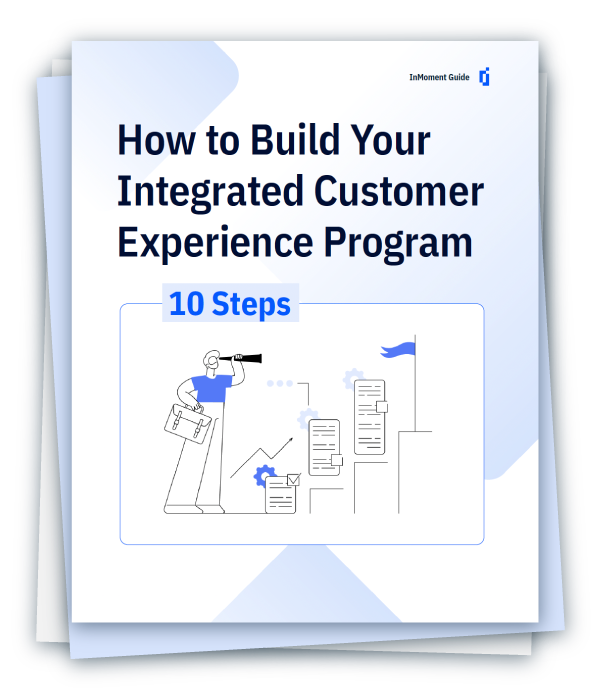A 4-Step Process for Aligning Every Employee Around Improving Customer Experience

The name of the game is collaboration. You may have an engineer delivering excellent code, or a business development associate pursuing opportunities for long term growth. If they aren’t working collaboratively with others on the goal of providing a fantastic customer experience, they are holding the company back.
Think about a particular employee at your organization or even one who reports directly to you. What is their job?
This deceivingly simple question has been posed repeatedly on stage by Fred Kofman, LinkedIn’s VP of Leadership and Organizational Development. The answer seems quite clear, and anyone would probably share with a stranger that they are Director of Marketing, Sales Associate, VP of Business Development, or whatever title their business card boasts.
But according to Fred, an employee’s job is not what people do, but the goals they pursue. What employees do becomes a means to an end, and “the end” for nearly every company is to win in the marketplace. That means individuals have to subordinate their role-based goals in order to hit the main goal. In most companies, regardless of a person’s role, winning for everyone means delighting each customer.
Silos Happen
In many organizations aligning the team around the customer experience can be tricky, because not every employee is customer facing. For example, a developer may spend all of her time working out bugs, without seeing the impact that has on the people actually using the software. Or your content marketing team might be working on educational materials to drive leads, but they’re forgetting that they are indirectly contributing to customer delight.
All employees should be focused on the customer, since the customer experience is the differentiating factor in our highly competitive marketplace. But all too often, employees get so focused on their individual and team goals that they lose awareness of the big picture. This is exacerbated when resources are scarce and teams get possessive with budgets or support staff, like designers and engineers.
So how do you keep employees focused on individual goals, while aligning the entire team around the number one thing that should be focused on – the customer experience?
There are indirect ways in which an employee can improve the customer experience every day simply by being more aware of customer needs. For example, a product team member can solicit input from the customer success team, thereby building customer feedback into the roadmap. There are also more direct ways of having people get their hands dirty and interacting with customers, even if they aren’t in a customer facing role.
Below is a four-step process for aligning every employee around the customer experience:
1. Metricize customer experience using Net Promoter Score
As the old adage goes, “what gets measured gets done.” Measuring customer happiness helps elevate awareness to the C-Suite where it can “compete” with things that are often easier to measure like leads, sales, and profits. There are a number of metrics that companies can use to measure their success, but NPS is the leader. It has been shown to correlate with revenue growth, profitability and other desired business outcomes.
NPS or Net Promoter Score, is now easy to do in real time via software. It is calculated by asking customers this question: On a scale from 0 to 10, how likely are you to recommend {product or service} to a friend or colleague? Responses in the 0 to 6 range are considered detractors, 7 to 8 are passive, and 9-10 are promoters. To calculate your NPS score, subtract the percentage of respondents who are detractors from the percentage of respondents who are promoters.
Get the new ebook, The Modern Guide to Winning Customers with Net Promoter Score. Learn eight ways that companies are leveraging Net Promoter Score to create a culture of customer happiness.
2. Share company-wide and engage everyone
NPS is something that is often shared weekly or monthly with the entire team. Everyone can track trends and read specific feedback to see why it has improved or declined. Once you have the score, dedicate a monitor in the office to display NPS data in real time. This can be for all of your customers or by different customer segment.
Another powerful outcome from NPS surveys are the testimonials (or negative feedback) you receive about your offering. This should absolutely be shared company-wide. The best words that marketing or sales can use to speak to prospective customers are the very words that existing customers already use to describe the benefits of your product. Great testimonials can also be shared verbatim on your website, with customer permission.
Or try sharing customer feedback directly with the development team. Non-technical employees may have a difficult time conveying to engineers exactly what changes to make to the product. Details get lost in translation, and the how and why are left out of the conversation around what is to be built. But when customer feedback is added to contextualize the software change requested, the customer needs can be met more specifically and efficiently.
3) Take action to improve the customer experience
Are your team members empowered to take action based on what they have learned about the customer experience? Are they comfortable working across silos? Make sure you have plans in place to close the loop with customers, and that customer feedback is getting to all the relevant functions for action. For example, Customer Success needs NPS data to monitor and improve customer health, Sales and Marketing are looking for promoters, Product can use the data to prioritize features.
The first step here is clear communication. Company leaders are responsible for setting high-level goals to delight customers, and sharing them so that everyone at the company is on the same page. Then managers can set individual and team goals in-line with the greater company initiatives. For this to work, communication across teams must be open, clear, and encouraged. Ideally you can hold cross-team planning sessions face to face. Or if you have a remote team or multiple offices and a limited travel budget, you can hold video meetings.
Once the plan is in place, it’s time to automate. Push your NPS data into existing platforms like CRM, customer support software and collaboration tools. When each function gets the data they need in real-time and has a plan to use it, customer experience will improve.
One of the great ways we automate at Wootric, is to see our own NPS feedback in a Slack channel. Everyone gets the unfiltered feedback. We all get to “high five” when another customer scores us as a 10. If there is ever an issue, the product team is quick to offer support to resolve issues. When everyone is focused on customer happiness, the job of the customer-facing roles like customer success and support is much easier.
4) Talk to customers
From the CEO to the accounts receivable manager, a great initiative that has everyone align around the customer experience is joining customer calls and then responding directly to customers via phone or email. People may be reluctant at first, but the C-suite can set the tone for the organization. Steve Jobs was famous for personally responding to customer emails, or proactively calling customers to inquire about issues and resolve them. What could be more appealing to a customer than a call or email from the CEO, the person who is most passionate about the customer’s success using the company’s product or service?
The CEO can probably handle this with his or her eyes closed, but asking every employee interact with customers may take some discretion and/or training. Not everyone has the skills and talents necessary to respond directly to customers. Handle this initiative like a training for a new customer representative, with a more senior person on the call ready to jump in or giving approval before an email is sent. It is worth it, though. When everyone on the team interacts with customers, even occasionally, they are able to maintain empathy and are reminded of the goal of their efforts.
At Wootric, our goal is to help our customers win their own customers for life using our Net Promoter Score platform. The first step in aligning the team around the customer experience is learning exactly what that experience is via data and detailed feedback. That information can then be shared company-wide so that everyone lives and breathes the customer experience. Step three is taking actions based on what customers really want, and step four is delighting them — and maintaining empathy — with direct communication. After all, customer delight is every employee’s job, no matter what their business card says.
Start getting in-app Net Promoter Score feedback today.
Sign up for free with Pearl-Plaza.


